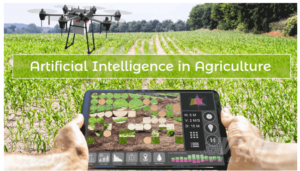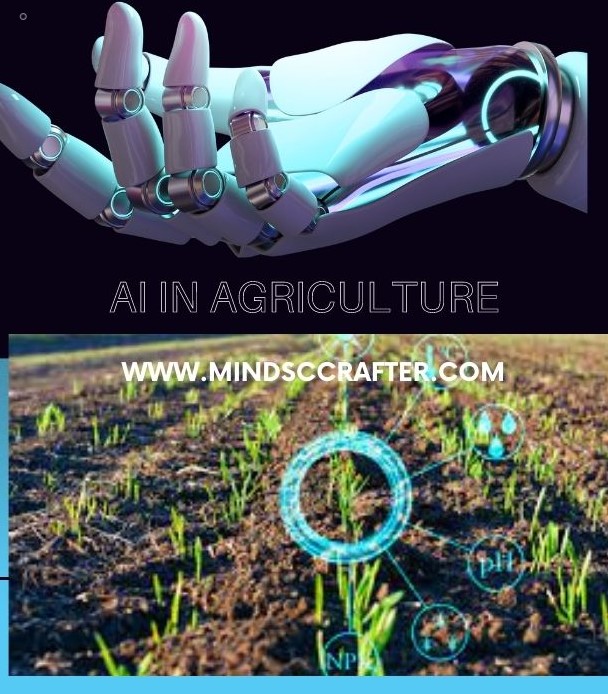
The AI Revolution in Agriculture: A Game-Changer for Sustainable Farming
The world is changing, and with it, our agricultural practices. As we strive to feed an ever-increasing global population, we must find ways to do so sustainably. Enter the AI revolution in agriculture, a game-changer for sustainable farming. The use of artificial intelligence in agriculture has the potential to revolutionize the way we grow crops, manage livestock, and optimize resource use. From crop monitoring to soil analysis and even automated harvesting, AI transforms food production. By harnessing the power of machine learning and big data, farmers can make more informed decisions and achieve better yields while reducing their environmental footprint. This article will explore the ways in which AI is being used in agriculture and the potential benefits for farmers, consumers, and the planet. So, let’s dive into the exciting world of AI in agriculture and discover how it’s changing the game for sustainable farming.
Benefits of AI in Sustainable Farming
The benefits of AI in sustainable farming are numerous. First and foremost, AI can help farmers make more informed decisions. With the help of sensors and other monitoring technologies, farmers can collect real-time data on soil moisture, temperature, and other key variables. This data can then be analyzed using AI algorithms to help farmers decide about planting, irrigation, and fertilization. By using AI, farmers can optimize their use of resources and reduce waste.
Another benefit of AI in sustainable farming is increased efficiency. With the help of AI-powered robots and drones, farmers can automate many labor-intensive tasks such as planting, weeding, and harvesting. This reduces labour costs and allows farmers to operate more efficiently and sustainably.
AI can also help farmers improve crop yields. By analyzing data on weather patterns, soil conditions, and other factors, AI algorithms can help farmers predict plant growth and identify potential problems before they occur. This allows farmers to take proactive measures to address issues and maximize yields.
Finally, AI in sustainable farming can help reduce the environmental impact of agriculture. By optimizing resource use and reducing waste, AI can help farmers reduce their carbon footprint and protect the environment.
How AI is Transforming Agriculture:
AI is transforming agriculture in many ways. One of the most significant is precision farming. Precision farming involves using sensors and other monitoring technologies to collect data on soil moisture, temperature, and other key variables. This data is then analyzed using AI algorithms to help farmers make more informed decisions about planting, irrigation, and fertilization.
Another way AI is transforming agriculture is through crop monitoring. By using drones and other monitoring technologies, farmers can monitor their crops in real-time and identify potential problems before they occur. This allows farmers to take proactive measures to address issues and maximize yields.
AI is also transforming agriculture through automated harvesting. With the help of AI-powered robots, farmers can automate the harvesting process, reducing labour costs and increasing efficiency. This saves time and money and allows farmers to operate more sustainably.
Finally, AI is transforming agriculture through predictive analytics. By analyzing data on weather patterns, soil conditions, and other factors, AI algorithms can help farmers predict plant growth and identify potential problems before they occur. This allows farmers to take proactive measures to address issues and maximize yields.
AI Applications in Agriculture – Precision Farming, Crop Monitoring, and Predictive Analytics
The applications of AI in agriculture are numerous. One of the most significant is precision farming. Precision farming involves using sensors and other monitoring technologies to collect data on soil moisture, temperature, and other key variables. This data is then analyzed using AI algorithms to help farmers make more informed decisions about planting, irrigation, and fertilization.
Another application of AI in agriculture is crop monitoring. By using drones and other monitoring technologies, farmers can monitor their crops in real-time and identify potential problems before they occur. This allows farmers to take proactive measures to address issues and maximize yields.
AI is also being used in agriculture for predictive analytics. By analyzing data on weather patterns, soil conditions, and other factors, AI algorithms can help farmers predict plant growth and identify potential problems before they occur. This allows farmers to take proactive measures to address issues and maximize yields.
Challenges and Limitations of AI in Agriculture:
Despite the potential benefits of AI in agriculture, there are also challenges and limitations to its implementation. One of the biggest challenges is the high cost of implementing AI technologies. Many farmers may need more resources to invest in AI, especially in developing countries.
Another challenge is the need for more data. AI algorithms require large amounts of data to be effective, and many farmers may need access to the necessary data.
There are also limitations to the effectiveness of AI in agriculture. For example, AI algorithms may be unable to account for unpredictable weather patterns or other unforeseen events.
Finally, there are ethical considerations to the use of AI in agriculture. For example, there may be concerns about using AI-powered robots to replace human labour.
Case Studies of AI in Agriculture – The Success Stories:
Despite the challenges and limitations, there are many success stories of AI in agriculture. One such success story is the use of precision farming in the United States. Farmers in the US have been able to optimize their use of resources and reduce waste by using sensors and other monitoring technologies.
Another success story is the use of drones in agriculture. By using drones to monitor crops, farmers in Brazil have been able to identify potential problems and take proactive measures to address them.
Finally, there is the success story of AI-powered robots in agriculture. By automating labour-intensive tasks such as planting and harvesting, farmers in Japan have been able to increase efficiency and reduce labour costs.
The Future of AI in Sustainable Farming:
The future of AI in sustainable farming is bright. As AI technologies become more affordable and accessible, more and more farmers will be able to take advantage of their benefits. We can expect to see increased use of precision farming, crop monitoring, and predictive analytics in the coming years.
We can also expect to see more advanced AI-powered robots and drones in agriculture. These technologies will allow farmers to automate even more tasks, increasing efficiency and reducing labour costs.
Finally, we can expect to see AI being used to address some of the biggest challenges facing agriculture, such as climate change and food security.
Ethical Considerations of AI in Agriculture:
As with any new technology, there are ethical considerations to using AI in agriculture. One of the biggest concerns is the potential for AI-powered robots to replace human labour. This could have significant social and economic impacts, especially in developing countries.
Another concern is the potential for AI to exacerbate existing inequalities in agriculture. For example, farmers with access to AI technologies may have a significant advantage over those without.
Finally, there are concerns about the potential for AI to be used for malicious purposes, such as hacking into farm systems or manipulating data.
The Impact of AI on Food Security and the Environment:
The impact of AI on food security and the environment is significant. By optimizing resource use and reducing waste, AI can help farmers produce more food while reducing their environmental footprint. This is especially important as we strive to feed an ever-increasing global population.
AI can also help address some of agriculture’s biggest challenges, such as climate change and water scarcity. AI algorithms can help farmers adapt to changing needs and maximize yields by analyzing weather patterns and soil conditions.
Finally, AI can help improve food safety. By analyzing data on food safety risks, AI can help identify potential problems and prevent foodborne illnesses.
Conclusion:
In conclusion, the AI revolution in agriculture is a game-changer for sustainable farming. By harnessing the power of machine learning and big data, farmers can make more informed decisions and achieve better yields while reducing their environmental footprint. While there are challenges and limitations to implementing AI in agriculture, the potential benefits are significant. As we continue to develop and refine AI technologies, we can expect to see even more exciting developments in the world of sustainable farming.



Pingback: AI and Climate Change